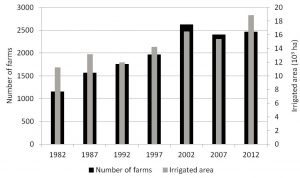Agricultural drainage removes excess water from the soil profile and helps sustain crops by improving the aeration and providing better trafficability of the soil. The benefits of drainage include reduced risk of crop loss from excess water stress, improved control of pest and diseases, and consistent crop yields under climate variability .
Although, the primary purpose of drainage has remained unchanged since 1800’s, the field of drainage has evolved significantly with respect to design, installation and management. Unlike the old drainage tiles installed randomly, the modern drainage systems tend to be more intense (narrow spacing) and more systematically installed with the use of modern machinery and better precision.
Recently, I contributed a chapter that describes the application of various GIS and GPS tools available for the planning, design and management of surface and subsurface drainage systems. We discuss steps to acquire and process relevant GIS and GPS data, methods for applying such data to the planning and design of drainage systems, and guidelines for managing drainage systems.
You can view and download a copy of the chapter at:
GIS and GPS Applications for Planning, Design and Management of Drainage Systems
I encourage you to take a look at some of the other chapters from this collection:




